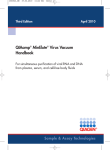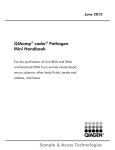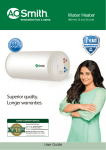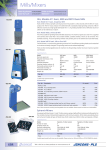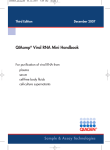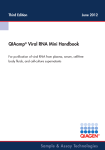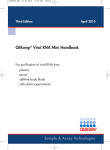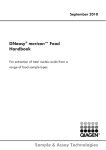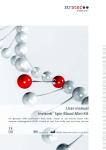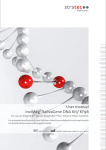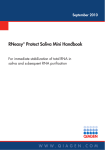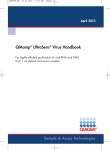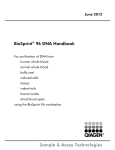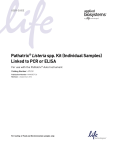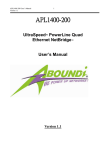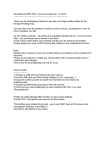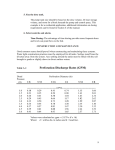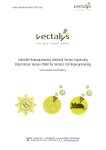Download Sample & Assay Technologies QIAamp® UCP
Transcript
April 2011 QIAamp® UCP PurePathogen Blood Handbook For simultaneous purification of bacterial, fungal, viral, and free-circulating nucleic acids from whole blood Sample & Assay Technologies QIAGEN Sample and Assay Technologies QIAGEN is the leading provider of innovative sample and assay technologies, enabling the isolation and detection of contents of any biological sample. Our advanced, high-quality products and services ensure success from sample to result. QIAGEN sets standards in: Purification of DNA, RNA, and proteins Nucleic acid and protein assays microRNA research and RNAi Automation of sample and assay technologies Our mission is to enable you to achieve outstanding success and breakthroughs. For more information, visit www.qiagen.com. Contents Kit Contents 4 Storage 5 Intended Use 5 Safety Information 6 Quality Control 7 Introduction 8 Principle and procedure 8 Description of protocols 12 Equipment and Reagents to Be Supplied by User 13 Important Notes 14 Preparation of buffers and reagents 14 QIAvac 24 Plus 14 Protocol Purification of Pathogen Nucleic Acids Including Freecirculating and Viral Nucleic Acids from 3 ml to 8 ml Fresh EDTA Treated Blood 20 Purification of Pathogen DNA from 3 ml to 8 ml Freeze/ Thawed EDTA Blood 24 Troubleshooting Guide 27 References 31 Appendix A: General Remarks 31 Ordering Information 32 QIAamp UCP PurePathogen Blood Handbook 04/2011 3 Kit Contents QIAamp UCP PurePathogen Blood Kit Catalog no. (10) 50112 Number of preps 10 QIAamp UCP Mini Columns 10 Collection Tubes (2.0 ml) 50 Pathogen Lysis Tubes L 10 Tube Extenders (20 ml) 10 Elution Tubes (1.5 ml) 50 VacConnectors 50 Buffer APR* 14 ml Buffer APL1† 56 ml Buffer APL2‡ 46 ml Buffer APB1‡ (concentrate) 3 x 20 ml Buffer APW1‡ (concentrate) 6 ml Buffer APW2* (concentrate) 4 ml Buffer AVE* 3 vials Reagent DX 1 vial RNase-free water* 15 ml Proteinase K 6 ml Handbook 1 * Contains sodium azide as a preservative. † Contains small amounts of guanidine thiocyanate. ‡ Contains chaotropic salt. See page 6 for safety information. 4 QIAamp UCP PurePathogen Blood Handbook 04/2011 Storage QIAamp UCP Mini columns should be stored at 2–8°C upon arrival. However, short-term storage (up to 4 weeks) at room temperature (15–25°C) does not affect their performance. All buffers can be stored at room temperature (15–25°C). The QIAamp UCP PurePathogen Blood Kit contains a ready-to-use Proteinase K solution, which is dissolved in a specially formulated storage buffer. The Proteinase K is stable for up to 1 year after delivery when stored at room temperature (15–25°C). To prolong the lifetime of Proteinase K, storage at 2–8°C is recommended. The QIAamp UCP Mini Columns and all buffers within the QIAamp UCP PurePathogen Blood Kit undergo proprietary DNA decontamination processes and are certified to have no detectable contaminating microbial DNA at the time of delivery. Intended Use The QIAamp UCP PurePathogen Blood Kit is intended for molecular biology applications. This product is not intended for the diagnosis, prevention, or treatment of a disease. All due care and attention should be exercised in the handling of the products. We recommend all users of QIAGEN products to adhere to the NIH guidelines that have been developed for recombinant DNA experiments, or to other applicable guidelines. QIAamp UCP PurePathogen Blood Handbook 04/2011 5 Safety Information When working with chemicals, always wear a suitable lab coat, disposable gloves, and protective goggles. For more information, please consult the appropriate material safety data sheets (MSDSs). These are available online in convenient and compact PDF format at www.qiagen.com/Support/MSDS.aspx where you can find, view, and print the MSDS for each QIAGEN kit and kit component. CAUTION: DO NOT add bleach or acidic solutions directly to waste containing Buffer APL1, Buffer APL2, Buffer APB1 or Buffer APW1. Buffer APL1, Buffer APL2, Buffer APB1, and Buffer APW1 contain guanidine salts, which can form highly reactive compounds when combined with bleach. If liquid containing these buffers is spilt, clean with suitable laboratory detergent and water. If the spilt liquid contains potentially infectious agents, clean the affected area first with laboratory detergent and water, and then with 1% (v/v) sodium hypochlorite. The following risk and safety phrases apply to components of QIAamp UCP PurePathogen Blood Kit. Buffer APL2, and Buffer APB1 Contain guanidine thiocyanate: harmful. Risk and safety phrases:* R20/21/2232, S13-26-36/37/39-46 Buffer APW1 Contains guanidine hydrochloride: harmful, irritant. Risk and safety phrases:* R22-36/38, S13-26-36-46 Proteinase K Contains proteinase K: sensitizer, irritant. Risk and safety phrases:* R36/37/38-42/43, S23-24-26-36/37 * R20/21/22: Harmful by inhalation, in contact with skin and if swallowed; R22: Harmful if swallowed; R32: Contact with acids liberates very toxic gas; R36/37/38: Irritating to eyes, respiratory system and skin; R36/38: Irritating to eyes and skin; R42/43: May cause sensitization by inhalation and skin contact; S13: Keep away from food, drink and animal feeding stuffs; S23: Do not breathe vapor; S24: Avoid contact with the skin; S26: In case of contact with eyes, rinse immediately with plenty of water and seek medical advice; S36: Wear suitable protective clothing; S36/37: Wear suitable protective clothing and gloves; S36/37/39: Wear suitable protective clothing, gloves and eye/face protection; S46: If swallowed, seek medical advice immediately and show container or label. 6 QIAamp UCP PurePathogen Blood Handbook 04/2011 24-hour emergency information Emergency medical information in English, French, and German can be obtained 24 hours a day from: Poison Information Center Mainz, Germany Tel: +49-6131-19240 Quality Control In accordance with QIAGEN’s ISO-certified Quality Management System, each lot of QIAamp UCP PurePathogen Blood Kit is tested against predetermined specifications to ensure consistent product quality. QIAamp UCP PurePathogen Blood Handbook 04/2011 7 Introduction The QIAamp UCP PurePathogen Blood Kit uses ultraclean production (UCP) technology. The QIAamp UCP PurePathogen Blood Kit enables purification of nucleic acids from bacteria and fungi, which are difficult to lyse, as well as viral and free circulating nucleic acids from fresh or frozen EDTA treated whole blood samples, with depletion of human genomic DNA. The eluted nucleic acids, including viral, bacterial and fungal nucleic acids, are ready for use in common downstream reactions or storage at –20 to –30°C. The purified nucleic acids have no detectable contaminating proteins, nucleases, and other impurities. Principle and procedure For maximal sensitivity in detection of pathogens from whole blood samples, large blood volumes are needed to purify nucleic acids because pathogen titers are often very low. Eluates from whole blood purification usually contain high concentrations of human DNA that could inhibit downstream reactions. The QIAamp UCP PurePathogen Blood Kit is designed to reduce this inhibition by depletion of human genomic DNA. The QIAamp UCP PurePathogen Blood Kit procedure comprises the following steps: 1. Separation of blood plasma from cellular fraction 2. Lysis of blood cells and depletion of human DNA within cellular fraction 3. Mechanical pre-lysis of bacteria and fungi 4. Combination of pre-lysed pathogens with plasma 5. Purification of pathogen nucleic acid (lyse, bind, wash, elute) In the first step, the plasma layer containing viruses and free-circulating nucleic acids is separated from the cellular fraction through centrifugation and then kept for later use. Next, after specific lysis of the blood cells, the microbial cells are enriched by centrifugation, followed by a mechanical pre-lysis step that enables the efficient disruption of difficult-to-lyse bacteria and fungi cells. The resulting cell lysate is then combined with the plasma fraction containing the viral and free-circulating nucleic acids. To co-purify viral and free-circulating nucleic acids, blood samples must be fresh. However, purification of bacterial and fungal nucleic acids from up to 8 ml of thawed blood samples is possible when using the dedicated protocol for freeze/thawed blood samples (see “Protocol: Purification of Pathogen DNA from 3 ml to 8 ml Freeze/Thawed EDTA Blood”, page 24). 8 QIAamp UCP PurePathogen Blood Handbook 04/2011 The QIAamp UCP PurePathogen Blood Protocols use extension tubes and vacuum processing on the QIAvac 24 Plus to enable starting sample volumes of up to 8 ml blood and flexible elution volumes from 50 μl to 200 μl. The robust procedure helps to eliminate sample-to-sample cross-contamination and increases user safety when handling potentially infectious samples. The simple process is highly suited for simultaneous processing of multiple samples and provides purified nucleic acids in less than 2 hours per 10 samples. QIAamp UCP PurePathogen Blood Handbook 04/2011 9 QIAamp UCP PurePathogen Procedure +1 Volume blood lysis buffer Discard supernatant Mechanical pre-lysis of microbial Pellet Add Lysis Buffer APL2 and Proteinase K Lyse Bind Vacuum Wash Vacuum Elute Pure nucleic acids 10 QIAamp UCP PurePathogen Blood Handbook 04/2011 Sample volumes and material The QIAamp UCP PurePathogen Blood Kit has been optimized for large sample volumes of up to 8 ml blood and comes with specific protocols for fresh as well as thawed blood. Lysing samples Due to their rigid cell wall, bacterial and fungal cells require a mechanical prelysis step to ensure complete lysis. Samples are suspended with Buffer APR, transferred to Pathogen Lysis Tubes and vortexed. Samples are then lysed under highly denaturing conditions at elevated temperatures in the presence of Proteinase K and Buffer APL2 to ensure lysis of viruses, inactivation of nucleases and complete release of nucleic acids from pre-lysed microbial cells. Adsorption to the QIAamp Mini membrane Binding conditions are adjusted by adding Buffer APB1 to allow optimal binding of the pathogen nucleic acids to the membrane. Lysates are then transferred onto a QIAamp UCP Mini column, and the pathogen nucleic acids are adsorbed onto the silica membrane as the lysate is drawn through by vacuum pressure. Salt and pH conditions ensure that proteins and other contaminants, which can inhibit downstream reactions, are not retained on the QIAamp Mini membrane. A vacuum manifold (e.g., the QIAvac 24 Plus with the QIAvac Connecting System) and a vacuum pump capable of producing a vacuum of –800 to –900 mbar (e.g., QIAGEN Vacuum Pump) are required for the protocol. A vacuum regulator should be used for easy monitoring of vacuum pressures and convenient vacuum releases. Removal of residual contaminants Nucleic acids remain bound to the membrane, while contaminants are efficiently washed away during 3 wash steps. In a single step, highly pure pathogen nucleic acids are eluted in Buffer AVE, equilibrated to room temperature. Elution of purified nucleic acids from pathogens Elution is performed using Buffer AVE. The elution volume can be as low as 50 μl. If higher nucleic acid concentrations are required, the elution volume can be reduced to as low as 20 μl. Low elution volume leads to highly concentrated eluates. For downstream applications that require small starting volumes, a more concentrated eluate may increase assay sensitivity. QIAamp UCP PurePathogen Blood Handbook 04/2011 11 For downstream applications that require a larger starting volume or for multiple analysis, the elution volume can be increased up to 200 μl. However, an increase in elution volume will decrease the concentration of nucleic acids in the eluate. The eluate volume recovered can be up to 5 μl less than the volume of elution buffer applied to this column; for example, an elution volume of 20 μl results in ≤15 μl final eluate. The volume of eluate recovered depends on the nature of the sample. Eluted DNA is collected in 1.5 ml microcentrifuge tubes (provided). If the purified nucleic acids are to be stored for up to 24 hours, storage at 2–8°C is recommended. For periods of storage longer than 24 hours, storage at –15 to –30°C is recommended. Yield and size of nucleic acids Although the QIAamp UCP PurePathogen Blood Kit significantly reduces the amount of human nucleic acids to prevent downstream inhibition, the eluates still contain human DNA. Yields of pathogen nucleic acids isolated from biological samples are normally below 1 μg and therefore cannot be distinguished by a spectrophotometer. The size distribution of pathogen nucleic acids purified using this procedure can be checked by agarose gel electrophoresis and hybridization to a target specific labeled probe (Sambrook, J. and Russell, D.W. [2001] Molecular Cloning: a Laboratory Manual, 3rd ed. Cold Spring Harbor, NY: Cold Spring Harbor Laboratory Press.) Description of protocols Different protocols are provided for human blood: fresh or thawed blood. The “Protocol: Purification of Pathogen Nucleic Acids Including Free-circulating and Viral Nucleic Acids from 3 ml to 8 ml Fresh EDTA Treated Blood”, page 20 is for processing 3–8 ml fresh blood. The “Protocol: Purification of Pathogen DNA from 3 ml to 8 ml Freeze/Thawed EDTA Blood”, page 24 is designed for purification of 3–8 ml thawed human blood. 12 QIAamp UCP PurePathogen Blood Handbook 04/2011 Equipment and Reagents to Be Supplied by User When working with chemicals, always wear a suitable lab coat, disposable gloves, and protective goggles. For more information, consult the appropriate material safety data sheets (MSDSs), available from the product supplier. Pipets (adjustable) Sterile pipet tips (pipet tips with aerosol barriers are recommended to help prevent cross-contamination) Water bath or heating block capable of holding 50 ml centrifuge tubes at 60°C Heating block or similar at 56°C (capable of holding 2 ml collection tubes) Microcentrifuge Microcentrifuge tubes (2 ml) Vortexer with Microtube foam insert (cat. no. 504-0234-00) or TurboMix® Attachment (cat. no. SI-0563), both available from Scientific Industries; TissueLyser LT (cat. no. 85600), which is available from QIAGEN; or FASTPREP®-24 (cat. no. 116003500) which is available from MP Biomedicals. Sterile 15 ml and 50 ml centrifuge tubes Centrifuge with rotor for 15 ml and 50 ml centrifuge tubes Vacuum manifold (e.g., QIAvac 24 Plus, cat. no. 19413) Vacuum Regulator (cat. no. 19530) for easy monitoring of vacuum pressures and easy releasing of vacuum Ethanol (96–100%)* Isopropanol (100%) Optional: VacValves (cat. no. 19408) Optional: QIAvac Connecting System (cat. no. 19419) * Do not use denatured alcohol, which contains other substances such as methanol or methylethylketone. QIAamp UCP PurePathogen Blood Handbook 04/2011 13 Important Notes Preparation of buffers and reagents Buffer APR Before use, add 100 μl Reagent DX to one bottle of buffer APR. If smaller amounts are needed, before use transfer 1.5 ml of buffer APR into a sterile 2 ml vial and add 10 μl Reagent DX. Mix well after adding Reagent DX. After preparation the mixture is stable for 6 months at room temperature (15–25°C). Buffer APB1* Before use, add 40 ml isopropanol (100%) to one bottle of buffer APB1 concentrate (20 ml) to obtain 60 ml Buffer APB1. Mix well after adding isopropanol. Buffer APW1* Before use, add 8 ml ethanol (96–100%) to 6 ml buffer APW1 concentrate to obtain 14 ml Buffer APW1. Mix well after adding ethanol. Buffer APW2† Before use, add 10 ml ethanol (96–100%) to 4 ml buffer APW2 concentrate to obtain 14 ml Buffer APW2. Mix well after adding ethanol. QIAvac 24 Plus The QIAvac 24 Plus is designed for fast and efficient vacuum processing of up to 24 QIAGEN spin columns in parallel. Samples and wash solutions are drawn through the column membranes by vacuum instead of centrifugation, providing greater speed and reduced hands-on time in purification procedures. In combination with the QIAvac Connecting System (optional), the QIAvac 24 Plus can be used as a flow-through system. The sample flow-through is collected in a separate waste bottle. For maintenance of the QIAvac 24 Plus, refer to the handling guidelines in the QIAvac 24 Plus Handbook. * Contains chaotropic salt. See page 6 for safety information. † Contains sodium azide as a preservative. 14 QIAamp UCP PurePathogen Blood Handbook 04/2011 Processing QIAamp UCP Mini columns on the QIAvac 24 Plus QIAamp UCP Mini columns are processed on the QIAvac 24 Plus using disposable VacConnectors and reusable VacValves. VacValves (optional) are inserted directly into the luer slots of the QIAvac 24 Plus manifold and ensure a steady flow rate, facilitating parallel processing of samples of different types (e.g., blood and body fluids), volumes, or viscosities. They should be used if sample flow rates differ significantly in order to ensure consistent vacuum. VacConnectors are disposable connectors that fit between QIAamp UCP Mini columns and VacValves or between the QIAamp UCP Mini columns and the luer slots of the QIAvac 24 Plus. They prevent direct contact between the spin column and VacValve during purification, thereby avoiding any crosscontamination between samples. VacConnectors are discarded after a single use. Handling guidelines for the QIAvac 24 Plus Always place the QIAvac 24 Plus on a secure bench top or work area. If dropped, the QIAvac 24 Plus manifold may crack. Always store the QIAvac 24 Plus clean and dry. For cleaning procedures see the QIAvac 24 Plus Handbook. The components of the QIAvac 24 Plus are not resistant to certain solvents (Table 1). If these solvents are spilled on the unit, rinse it thoroughly with water. To ensure consistent performance, do not apply silicone or vacuum grease to any part of the QIAvac 24 Plus manifold. Always use caution and wear safety glasses when working near a vacuum manifold under pressure. Contact QIAGEN Technical Services or your local distributor for information concerning spare or replacement parts. The vacuum pressure is the pressure differential between the inside of the vacuum manifold and the atmosphere (standard atmospheric pressure 1013 millibar or 760 mm Hg) and can be measured using the QIAvac Connecting System or a vacuum regulator (see Figure 1). The protocols require a vacuum pump capable of producing a vacuum or –800 to –900 mbar (e.g., QIAGEN Vacuum Pump). Higher vacuum pressures must be avoided. Use of vacuum pressures lower than recommended may reduce nucleic acid yield and purity and increase the risk of clogged membranes. Make sure that the connections between the vacuum pump, QIAvac 24 Plus, and the optional QIAvac Connecting System are checked for tightness on a daily basis to ensure sufficient vacuum strength. QIAamp UCP PurePathogen Blood Handbook 04/2011 15 Figure 1. Schematic diagram of the Vacuum Regulator. Table 1. Chemical resistance properties of QIAvac 24 Plus Resistant to: Acetic acid Chromic acid SDS Tween® 20 Chaotropic salts Chlorine bleach Concentrated alcohols Hydrochloric acid Sodium chloride Sodium hydroxide Urea Not resistant to: Benzene Phenol 16 Chloroform Ethers Toluene QIAamp UCP PurePathogen Blood Handbook 04/2011 Setup of the QIAvac Plus vacuum manifold 1. Connect the QIAvac 24 Plus to a vacuum source. If using the QIAvac Connecting System, connect the system to the manifold and vacuum source as described in Appendix A of the QIAvac 24 Plus Handbook. Note: Close the outlets of the QIAvac 24 Plus using the plugs which are provided with the system or by closing the VacValves. Apply vacuum using vacuum pump and ensure that pressure of –800 to –900 mbar is achieved. Repeat this procedure every day before operation of the QIAvac system. 2. Insert a VacValve (optional) into each luer slot of the QIAvac 24 Plus that is to be used (see Figure 2). Close unused luer slots with luer plugs or close the inserted VacValve. VacValves should be used if flow rates of samples differ significantly to ensure consistent vacuum. 3. Insert a VacConnector into each VacValve (see Figure 2). Perform this step directly before starting the purification to avoid exposure of VacConnectors to potential contaminants in the air. 4. Place the QIAamp UCP Mini columns into the VacConnectors on the manifold (see Figure 2). Note: Save the collection tube from the blister pack for use in the purification protocol. 5. Insert a tube extender (20 ml) into each QIAamp UCP Mini column (see Figure 2). Note: Make sure that the tube extender is firmly inserted into the QIAamp UCP Mini column in order to avoid leakage of sample 6. For nucleic acid purification, follow the instructions in the protocols. Discard the VacConnectors appropriately after use. Leave the lid of the QIAamp UCP Mini column open while applying vacuum. Switch off the vacuum between steps to ensure that a consistent, even vacuum is applied during processing. For faster vacuum release, a vacuum regulator should be used (see Figure 1). Note: Each VacValve can be closed individually when the sample is completely drawn through the spin column, allowing parallel processing of samples of different volumes or viscosities. 7. After processing samples, clean the QIAvac 24 Plus (see “Cleaning and Decontaminating the QIAvac 24 Plus” in the QIAvac 24 Plus Handbook). Note: Buffers APL1, APL2, APB1, and APW1 are not compatible with disinfecting agents containing bleach. See page 6 for safety information. QIAamp UCP PurePathogen Blood Handbook 04/2011 17 6 5 4 3 2 1 Figure 2. Setting up the QIAvac 24 Plus with QIAamp UCP Mini columns using VacValves, VacConnectors, and Tube Extenders. 1. QIAvac 24 Plus vacuum manifold 4. VacConnector 2. Luer slot of the QIAvac 24 Plus (closed with luer plug) 5. QIAamp UCP Mini column 3. VacValve* 6. Tube Extender * Must be purchased separately. We recommend labeling the tubes and the QIAamp UCP Mini columns for use on the QIAvac 24 Plus vacuum system according to the scheme in Figure 3 in order to avoid the mix-up of samples. This figure can be photocopied and labeled with the names of the samples. 18 QIAamp UCP PurePathogen Blood Handbook 04/2011 Date: ____________________________________________________________ Operator: ________________________________________________________ Run ID: ___________________________________________________________ Figure 3. Labeling scheme for tubes and QIAamp UCP Mini columns for use on the QIAvac 24 Plus vacuum system. QIAamp UCP PurePathogen Blood Handbook 04/2011 19 Protocol: Purification of Pathogen Nucleic Acids Including Free-circulating and Viral Nucleic Acids from 3 ml to 8 ml Fresh EDTA Treated Blood This protocol is for purification of bacterial, fungal, viral and free-circulating acids with parallel depletion of human DNA from up to 8 ml of fresh EDTA treated human blood. Things to do before starting Equilibrate samples to room temperature (15–25°C). Set up the QIAvac 24 Plus as described on pages 17–20. Heat a water bath or heating block to 60°C for use with 50 ml centrifuge in step 15. Heat a heating block to 56°C for use with 2 ml collection tubes in step 23. Ensure that Buffer APR, Buffer APB1, Buffer APW1, and Buffer APW2 have been prepared according to the instructions on page 14. Procedure 1. Place 3–8 ml of fresh blood into a 15 ml centrifuge tube (not provided). Close the cap and centrifuge (5,000 x g) for 10 min. This step separates plasma from blood and microbial cells, with one volume of fresh blood approximately separating into 50% cell fraction and 50% plasma fraction. 2. Open the cap and carefully transfer the upper plasma layer (plasma fraction) into a sterile 50 ml centrifuge tube (not provided). Save the plasma later for step 11. Note: Do not disturb the white blood cell layer when transferring the plasma layer. 3. Add approximately 1 volume of Buffer APL1 to the remaining cell fraction from step 1 and resuspend the pellet by vigorous vortexing and pipetting for 30 s. For instance, add approximately 4 ml Buffer APL1 to 4 ml of the remaining cell fraction (not total volume of blood provided in step 1). Buffer APL1 specifically lyses human blood cells while microbial cells stay intact. 4. Close the tube and incubate the cell fraction–buffer mixture for 10 min at room temperature (15–25°C). 5. Centrifuge the cell fraction–buffer mixture for 10 min (5,000 x g). 6. Carefully discard the supernatant but save the microbial cell pellet. 20 QIAamp UCP PurePathogen Blood Handbook 04/2011 Note: Do not vigorously shake the tube while discarding the supernatant. A small fraction of liquid (~300–500 μl flowback) will not disturb the process. Too vigorous shaking or decanting may lead to the loss of the microbial cells. Due to low pathogen titers the microbial pellet is not visible in most cases. Proceed with the process even if you do not observe the pellet at the bottom of the tube. Note: Steps 6a–6d are optional steps that can be performed to further decrease the content of background human DNA. 6a. Add 500 μl RNase-free water to the centrifuge tube, resuspend the microbial pellet by pipetting, and transfer the whole volume into a fresh 1.5 ml centrifuge tube. 6b. Centrifuge the 1.5 ml tube for 5 min at 14,000 g in a microcentrifuge and discard the whole supernatant. 6c. Add 500 μl RNase-free water and resuspend the microbial pellet by pipetting. 6d. Add 250 μl buffer and proceed with step 8. 7. Add 250 μl of Buffer APR to the centrifuge tube and resuspend the microbial pellet by pipetting. 8. Transfer the contents of the cell fraction–buffer mixture (500–800 μl) into a fresh Pathogen Lysis Tube L and close the tube, tightly. 9. Vortex the Pathogen Lysis Tube L according to steps 9a or 9b. 9a. Place the Pathogen Lysis Tube L on the Microtube foam insert and vortex for 10 min at maximum speed. 9b. Place the Pathogen Lysis Tube L on a TissueLyser LT and disrupt for 10 min at 50 Hz or use the FastPrep-24 instrument and apply a velocity of 6.5 m/s for 2 x 45s with a 5 min intermission. 10. Remove the Pathogen Lysis Tube L from the vortexer and incubate the tube for 3 min at room temperature (15–25°C) to reduce the foam in the tube. Do not centrifuge. 11. Carefully transfer the supernatant from the Pathogen Lysis Tube L into the plasma-fraction tube while carefully keeping the glass beads from being transferred into the plasma-fraction from step 2. This step combines the mechanically pre-lysed microbial cells with the freecirculating nucleic acids and the viruses. 12. Wash the glass beads by adding 500 μl RNase-free water to the Pathogen Lysis Tube L. Close the lid. Vortex and transfer 500 μl of the supernatant to the plasma mixture from step 11. Discard the Pathogen Lysis Tube. 13. Add 500 μl Proteinase K to the tube, close the cap, and mix by pulse vortexing for 10 s. QIAamp UCP PurePathogen Blood Handbook 04/2011 21 14. Add 4 ml of Buffer APL2 to the tube, close the cap, and mix by pulsevortexing for 10 s. 15. Incubate tube at 60°C for 15 min. 16. Briefly spin the tube to remove drops from the inside of the lid. 17. Add 16 ml of Buffer APB1 to the lysate, close the cap, and mix thoroughly by pulse-vortexing for 15–30 s. 18. Carefully apply the lysate from step 17 into the extension tube of the QIAamp UCP Mini column. Switch on the vacuum pump. When all lysates have been drawn through the columns completely, switch off the vacuum pump and release the pressure to 0 mbar. 19. Apply 600 μl of Buffer APW1 to the QIAamp UCP Mini column. Carefully remove and discard the extension tube and switch on the vacuum pump. After all of Buffer APW1 has been drawn through the Mini column, switch off the vacuum pump and release the pressure to 0 mbar. To avoid cross contaminations be careful to not cross neighboring QIAamp UCP Mini Columns while extension tubes are removed. 20. Apply 750 μl of Buffer APW2 to the QIAamp UCP Mini column. Leave the lid of the column open and switch on the vacuum pump. After all of Buffer APW2 has been drawn through the Mini column, switch off the vacuum pump and release the pressure to 0 mbar. 21. Apply 750 μl of ethanol (96–100%) to the QIAamp UCP Mini column. Leave the lid of the column open and switch on the vacuum pump. After all of ethanol has been drawn through the spin column, switch off the vacuum pump and release the pressure to 0 mbar. 22. Close the lid of the QIAamp UCP Mini column, remove it from the vacuum manifold and discard the VacConnector. Place the QIAamp UCP Mini column in a clean 2 ml collection tube and centrifuge at full speed (20,000 x g; 14,000 rpm) for 3 min. 23. Place the QIAamp UCP Mini Column into a new 2 ml collection tube, open the lid and incubate the assembly at 56°C for 3 min to dry the membrane completely. 24. Place the QIAamp UCP Mini column in a clean 1.5 ml elution tube and discard the collection tube. Carefully apply 150 μl of Buffer AVE to the center of the QIAamp Mini membrane. Close the lid and incubate at room temperature for 3 min. IMPORTANT: Ensure that the elution buffer is equilibrated to room temperature. Elution volume is flexible and can be adapted according to the requirements of downstream applications. The recovered eluate volume will be up to 5 μl less than the elution volume applied onto the column. If elution is done in small volumes (<100 μl) the elution buffer has to be dispensed onto the center of the membrane for complete elution of bound 22 QIAamp UCP PurePathogen Blood Handbook 04/2011 DNA. Small elution volumes may lead to inhibition of downstream reactions. Determine the optional ratio of elution volume and the volume of eluate suitable for your downstream reaction, and reduce or increase the elution volume accordingly. 25. Centrifuge at full speed (20,000 x g; 14,000 rpm) for 1 min to elute the DNA. QIAamp UCP PurePathogen Blood Handbook 04/2011 23 Protocol: Purification of Pathogen DNA from 3 ml to 8 ml Freeze/Thawed EDTA Blood This protocol is for purification of bacterial and fungal nucleic acids with parallel depletion of human DNA from up to 8 ml thawed EDTA treated human blood. Things to do before starting Equilibrate samples to room temperature (15–25°C). Set up the QIAvac 24 Plus as described on pages 17–20. Heat a water bath or heating block to 60°C for use with 50 ml centrifuge in step 15. Heat a heating block to 56°C for use with 2 ml collection tubes in step 23. Ensure that Buffer APR, Buffer APB1, Buffer APW1, and Buffer APW2 have been prepared according to the instructions on page 14. Procedure 1. Place 3 to 8 ml of frozen then thawed blood into a 15 ml centrifuge tube (not provided). Close the cap and centrifuge (5,000 x g) for 10 min. 2. Open the cap and carefully pipette and discard the liquid supernatant, leaving approximately 500 μl cell fraction in the bottom of the tube. 3. Add 4 ml Buffer APL1 to the remaining cell fraction from step 2 and mix vigorously by pulse-vortexing for 30 s. Buffer APL1 specifically lyses human blood cells while microbial cells stay intact. In some cases, precipitates might occur which do not dissolve even after proper vortexing. Proceed with the procedure as described. 4. Incubate the cell fraction–buffer mixture for 10 min at room temperature (15–25°C). 5. Close the tube and centrifuge cell fraction–buffer mixture for 10 min (5,000 x g). 6. Carefully discard the supernatant but save the microbial cell pellet. Note: Do not vigorously shake the tube while discarding the supernatant. A small fraction of liquid (~300–500 μl flowback) will not disturb the process. Too vigorous shaking or decanting may lead to the loss of the microbial cells. Due to low pathogen titers the microbial pellet is not visible in most cases. Proceed with the process even if you do not observe the pellet at the bottom of the tube. 24 QIAamp UCP PurePathogen Blood Handbook 04/2011 Note: Steps 6a – 6d are optional steps that can be performed to further decrease the content of background human DNA. 6a. Add 500 μl RNase-free water to the centrifuge tube, resuspend the microbial pellet by pipetting, and transfer the whole volume into a fresh 1.5 ml centrifuge tube. 6b. Centrifuge the 1.5 ml tube for 5 min at 14,000 g in a microcentrifuge and discard the whole supernatant. 6c. Add 500 μl RNase-free water and resuspend the microbial pellet by pipetting. 6d. Add 250 μl buffer and proceed with step 8. 7. Add 250 μl of Buffer APR to the centrifuge tube and resuspend the microbial pellet by pipetting. 8. Transfer the contents of the cell fraction–buffer mixture (~500– 800 μl) into a fresh Pathogen Lysis Tube L and close the tube, tightly. 9. Vortex the Pathogen Lysis Tube L according to steps 9a or 9b. 9a. Place the Pathogen Lysis Tube L on the Microtube foam insert and vortex for 10 min at maximum speed. 9b. Place the Pathogen Lysis Tube L on a TissueLyser LT and disrupt for 10 min at 50 Hz or use the FastPrep-24 instrument and apply a velocity of 6.5 m/s for 2 x 45 s with a 5 min intermission. 10. Remove the Pathogen Lysis Tube L from the vortexer and incubate the tube for 3 min at room temperature (15–25°C) to reduce the foam in the tube. Do not centrifuge. 11. Carefully transfer the supernatant from the Pathogen Lysis Tube L into a fresh 15 ml tube, while carefully keeping the glass beads from being transferred into the tube. 12. Wash the glass beads by adding 500 μl RNase-free water to the Pathogen Lysis Tube L. Close the lid. Vortex, open lid, and transfer 500 μl of the supernatant to the tube from step 11. Discard the Pathogen Lysis Tube. 13. Add 100 μl Proteinase K to the 15 ml tube, close the cap, and mix by pulse-vortexing for 10 s. 14. Add 800 μl of Buffer APL2, close the cap, and mix by pulse-vortexing for 10 s. 15. Incubate tube at 60°C for 15 min. 16. Briefly spin the tube to remove drops from the inside of the lid. 17. Add 3.2 ml of Buffer APB1 to the lysate, close the cap, and mix thoroughly by pulse-vortexing for 15–30 s. QIAamp UCP PurePathogen Blood Handbook 04/2011 25 18. Carefully apply the lysate from step 17 into the extension tube of the QIAamp UCP Mini column. Switch on the vacuum pump. When all lysates have been drawn through the columns completely, switch off the vacuum pump and release the pressure to 0 mbar. 19. Apply 600 μl of Buffer APW1 to the QIAamp UCP Mini column. Carefully remove and discard the extension tube and switch on the vacuum pump. After all of Buffer APW1 has been drawn through the Mini column, switch off the vacuum pump and release the pressure to 0 mbar. Note: To avoid cross-contamination, be careful not to move the tube extenders over neighboring QIAamp UCP Mini Columns. 20. Apply 750 μl of Buffer APW2 to the QIAamp UCP Mini column. Leave the lid of the column open and switch on the vacuum pump. After all of Buffer APW2 has been drawn through the Mini column, switch off the vacuum pump and release the pressure to 0 mbar. 21. Apply 750 μl of ethanol (96–100%) to the QIAamp UCP Mini column. Leave the lid of the column open and switch on the vacuum pump. After all of ethanol has been drawn through the spin column, switch off the vacuum pump and release the pressure to 0 mbar. 22. Close the lid of the QIAamp UCP Mini column, remove it from the vacuum manifold and discard the VacConnector. Place the QIAamp UCP Mini column in a clean 2 ml collection tube and centrifuge at full speed (20,000 x g; 14,000 rpm) for 3 min. 23. Place the QIAamp UCP Mini column into a new 2 ml collection tube, open the lid and incubate the assembly at 56°C for 3 min to dry the membrane completely. 24. Place the QIAamp UCP Mini column in a clean 1.5 ml elution tube and discard the collection tube. Carefully apply 150 μl of Buffer AVE to the center of the QIAamp Mini membrane. Close the lid and incubate at room temperature for 3 min. IMPORTANT: Ensure that the elution buffer is equilibrated to room temperature. Elution volume is flexible and can be adapted according to the requirements of downstream applications. The recovered eluate volume will be up to 5 μl less than the elution volume applied onto the column. If elution is done in small volumes (<100 μl) the elution buffer has to be dispensed onto the center of the membrane for complete elution of bound DNA. Small elution volumes may lead to inhibition of downstream reactions. Determine the optional ratio of elution volume and the volume of eluate suitable for your downstream reaction, and reduce or increase the elution volume accordingly. 25. Centrifuge at full speed (20,000 x g; 14,000 rpm) for 1 min to elute the DNA. 26 QIAamp UCP PurePathogen Blood Handbook 04/2011 Troubleshooting Guide This troubleshooting guide may be helpful in solving any problems that may arise. For more information, see also the Frequently Asked Questions Page at our Technical Support Center: www.qiagen.com/FAQ/FAQList.aspx. The scientists in QIAGEN Technical Services are always happy to answer any questions you may have about either the information and protocols in this handbook or sample and assay technologies (for contact information, see back cover or visit www.qiagen.com). Comments and suggestions Little or no pathogen DNA in the eluate a) Primary blood tube contains an anticoagulant other than EDTA Anticoagulants other than EDTA may lead to accelerated DNA degradation compared to EDTA blood. Repeat the purification procedure with new samples. b) Pathogen cells may have been discarded along with the supernatant The pathogen cells may have been discarded along with the supernatant containing the human DNA. Be careful not to discard the microbial cells. c) Inefficient mechanical lysis of pathogens Make sure that the Pathogen Lysis Tube has been vortexed for 10 min at maximal speed using a Microtube foam insert of a Vortex-Genie®, a TissueLyser LT at 50 Hz, or a FASTPREP-24 instrument with 2 x 45 s with a 5 min intermission. d) Low-percentage ethanol used instead of 96–100% Repeat the purification procedure with new samples and 96–100% ethanol. Do not use denatured alcohol, which contains other substances such as methanol or methylethylketone. e) Buffer APB1 prepared incorrectly Check that Buffer APB1 concentrate was reconstituted with the correct volume of isopropanol (not ethanol, see page 14). f) Buffer APW1 or Buffer APW2 prepared incorrectly Check that Buffer APW1 and Buffer APW2 concentrates were diluted with the correct volume of ethanol (see page 14). Repeat the purification procedure with new samples. QIAamp UCP PurePathogen Blood Handbook 04/2011 27 Comments and suggestions g) Buffer APW1 or Buffer APW2 prepared with 70% ethanol Check that Buffer APW1 and Buffer APW2 concentrates were diluted with 96–100% ethanol (see page 14). Repeat the purification procedure with new samples. h) QIAamp UCP Mini column not incubated at room temperature (15–25°C) for 3 min After addition of Buffer AVE the QIAamp UCP Mini column should be incubated at room temperature for 3 min. High human DNA background a) Samples were kept for an extended time between blood draw and plasma preparation Blood cells may disintegrate and release genomic DNA into the plasma, diluting the target nucleic acid. Use the protocol for thawed blood. b) Inefficient lysis of leukocytes The human DNA gets discarded after lysis of the leukocytes using Buffer APL1. Make sure that the supernatant gets discarded after 10 min incubation at room temperature. Eluted nucleic acids do not perform well in downstream reactions a) Little or no DNA in the eluate See “Little or no nucleic acids in the eluate” above for possible reasons for little or no DNA in the eluate. Increase the amount of eluate added to the reaction if possible. b) Inappropriate elution volume used Determine the maximum volume of eluate suitable for your downstream reaction. Reduce or increase the volume of eluate added to the reaction accordingly. The elution volume can be adapted proportionally. c) Buffers not mixed thoroughly Salt and ethanol components of wash Buffer APW2 may have separated out after being left for a long period between runs. Always mix buffers thoroughly before each run. d) High human DNA background High amounts of human DNA in the eluate may inhibit downstream reactions. See “High human DNA background” above for possible reasons. Decrease the amount of eluate added to the reaction if possible. 28 QIAamp UCP PurePathogen Blood Handbook 04/2011 Comments and suggestions e) Buffers APW1 and APW2 used in the wrong order Ensure that Buffers APW1 and APW2 are used in the correct order in the protocol. Repeat the purification procedure with a new sample. f) Reduced sensitivity of downstream reaction Adjust the volume of eluate added to the downstream reaction. g) Residual ethanol in the eluate Use recommended drying step in the relevant protocol. General handling a) Vacuum pressure of 800–900 mbar not reached The vacuum manifold is not tightly closed. Close the outlets of the QIAvac 24 Plus using the plugs which are provided with the system or by closing the VacValves. Apply vacuum using vacuum pump and ensure that pressure of –800 to –900 mbar is achieved. Repeat this procedure every day before operation of the QIAvac system. Gasket of QIAvac lid has worn out. Check the seal of the manifold visually and replace it if necessary. VacValves have worn out. Remove all VacValves and insert VacConnectors directly into the luer extensions. Insert QIAamp UCP Mini columns into VacConnectors, close the lid of the columns, and switch on vacuum. Check if vacuum pressure is reached. Replace VacValves if necessary. Connection to vacuum pump is leaky. Close all luer extensions with luer caps, and switch on the vacuum pump. Check if vacuum pressure is stable after the pump is switched on (and the vacuum regulator valve is closed). Exchange the connections between pump and vacuum manifold if necessary. If the vacuum pressure is still not reached, replace the vacuum pump with a stronger one. If using the optional QIAvac Connecting System, check if assembly is correct according to instructions. QIAamp UCP PurePathogen Blood Handbook 04/2011 29 Comments and suggestions b) Inefficient proteinase digestion If Proteinase K was subjected to elevated temperature for a prolonged time, it can lose activity. Repeat the procedure using new samples and fresh Proteinase K. c) Clogged QIAamp UCP Mini column Close the VacValve, if used, and carefully remove the whole assembly consisting of tube extender, QIAamp UCP Mini column, VacConnector, and VacValve from the QIAvac 24 Plus manifold. Carefully transfer the remaining sample lysate from the tube extender to a new 50 ml tube. Remove the QIAamp UCP Mini column from the assembly (see above); place it in a 2 ml collection tube and spin it at full speed for 1 minute or until sample has completely passed through the membrane. Re-assemble the QIAamp UCP Mini column with Tube Extender, VacConnector and (optional) VacValve. Transfer the remaining sample lysate into the Tube Extender, switch on the vacuum pump, open the VacValve, and pass the remaining lysate through the QIAamp UCP Mini column. Repeat the above procedure if the QIAamp UCP Mini Column continues to clog. 30 QIAamp UCP PurePathogen Blood Handbook 04/2011 References QIAGEN maintains a large, up-to-date online database of scientific publications utilizing QIAGEN products. Comprehensive search options allow you to find the articles you need, either by a simple keyword search or by specifying the application, research area, title, etc. For a complete list of references, visit the QIAGEN Reference Database online at www.qiagen.com/RefDB/search.asp. Appendix A: General Remarks General handling Proper microbiological, aseptic technique should always be used when purifying nucleic acids with the QIAamp UCP PurePathogen Blood Kit. Hands and dust particles may carry bacteria and molds and are the most common sources of contamination. Always wear latex or vinyl gloves while handling reagents and consumables. Change gloves frequently and keep tubes closed whenever possible. Keep purified nucleic acids on ice when aliquots are pipetted for downstream applications. Disposable plasticware The use of sterile, disposable polypropylene tubes is recommended throughout the procedure. These tubes are generally free of contaminating nucleic acids as well as nuclease and do not require pretreatment. QIAamp UCP PurePathogen Blood Handbook 04/2011 31 Ordering Information Product Contents Cat. no. QIAamp UCP PurePathogen Kit (10) For 10 preps: QIAamp UCP Mini Columns, Pathogen Lysis Tubes L, Tube Extenders (20 ml), Proteinase K, Buffers, VacConnectors, and Collection Tubes (1.5 ml and 2 ml) 50112 QIAvac 24 Plus Vacuum manifold for processing 1–24 spin columns: includes QIAvac 24 Plus Vacuum Manifold, Luer Plugs, Quick Couplings 19413 VacValves (24) 24 valves for use with the QIAvac 24 Plus 19408 VacConnectors (500) 500 disposable connectors for use with QIAamp spin columns on luer slots or VacValves 19407 Vacuum Pump Universal vacuum pump (capacity 34 liters/min, 8 mbar vacuum abs.) Accessories 84010* 84000† 84020‡ QIAvac Connecting System System to connect vacuum manifold with vacuum pump: includes Tray, Waste Bottles, Tubing, Couplings, Valve, Gauge, 24 VacValve 19419 Collection Tubes (2 ml) 1000 Collection Tubes (2 ml) 19201 QIAGEN Proteinase K (2 ml) 2 ml (>600 mAU/ml, solution) 19131 QIAGEN Proteinase K (10 ml) 10 ml (>600 mAU/ml, solution) 19201 * US and Canada. † Japan. ‡ Rest of world. 32 QIAamp UCP PurePathogen Blood Handbook 04/2011 Notes QIAamp UCP PurePathogen Blood Handbook 04/2011 33 Notes 34 QIAamp UCP PurePathogen Blood Handbook 04/2011 Trademarks: QIAGEN®, QIAamp® (QIAGEN Group); FASTPREP® (MP Biomedicals, LLC); Vortex-Genie® (Scientific Industries, Inc.); TurboMix® (Bete Fog Nozzle, Inc.). Limited License Agreement Use of this product signifies the agreement of any purchaser or user of the QIAamp UCP PurePathogen Blood Kit to the following terms: 1. The QIAamp UCP PurePathogen Blood Kit may be used solely in accordance with the QIAamp UCP PurePathogen Blood Handbook and for use with components contained in the Kit only. QIAGEN grants no license under any of its intellectual property to use or incorporate the enclosed components of this Kit with any components not included within this Kit except as described in the QIAamp UCP PurePathogen Blood Handbook and additional protocols available at www.qiagen.com. 2. Other than expressly stated licenses, QIAGEN makes no warranty that this Kit and/or its use(s) do not infringe the rights of third-parties. 3. This Kit and its components are licensed for one-time use and may not be reused, refurbished, or resold. 4. QIAGEN specifically disclaims any other licenses, expressed or implied other than those expressly stated. 5. The purchaser and user of the Kit agree not to take or permit anyone else to take any steps that could lead to or facilitate any acts prohibited above. QIAGEN may enforce the prohibitions of this Limited License Agreement in any Court, and shall recover all its investigative and Court costs, including attorney fees, in any action to enforce this Limited License Agreement or any of its intellectual property rights relating to the Kit and/or its components. S For updated license terms, see www.qiagen.com. © 2011 QIAGEN, all rights reserved. www.qiagen.com Australia Orders 1-800-243-800 Fax 03-9840-9888 Technical 1-800-243-066 Austria Orders 0800-28-10-10 Fax 0800-28-10-19 Technical 0800-28-10-11 Belgium Orders 0800-79612 Fax 0800-79611 Technical 0800-79556 Brazil Orders 0800-557779 Fax 55-11-5079-4001 Technical 0800-557779 Canada Orders 800-572-9613 Fax 800-713-5951 Technical 800-DNA-PREP (800-362-7737) China Orders 86-21-3865-3865 Fax 86-21-3865-3965 Technical 800-988-0325 Denmark Orders 80-885945 Fax 80-885944 Technical 80-885942 Finland Orders 0800-914416 Fax 0800-914415 Technical 0800-914413 France Orders 01-60-920-926 Fax 01-60-920-925 Technical 01-60-920-930 Offers 01-60-920-928 Germany Orders 02103-29-12000 Fax 02103-29-22000 Technical 02103-29-12400 Hong Kong Orders 800 933 965 Fax 800 930 439 Technical 800 930 425 Ireland Orders 1800 555 049 Fax 1800 555 048 Technical 1800 555 061 Italy Orders 800-789-544 Fax 02-334304-826 Technical 800-787980 Japan Telephone 03-6890-7300 Fax 03-5547-0818 Technical 03-6890-7300 Korea (South) Orders 080-000-7146 Fax 02-2626-5703 Technical 080-000-7145 Luxembourg Orders 8002-2076 Fax 8002-2073 Technical 8002-2067 Mexico Orders 01-800-7742-639 Fax 01-800-1122-330 Technical 01-800-7742-436 The Netherlands Orders 0800-0229592 Fax 0800-0229593 Technical 0800-0229602 Norway Orders 800-18859 Fax 800-18817 Technical 800-18712 Singapore Orders 1800-742-4362 Fax 65-6854-8184 Technical 1800-742-4368 Spain Orders 91-630-7050 Fax 91-630-5145 Technical 91-630-7050 Sweden Orders 020-790282 Fax 020-790582 Technical 020-798328 Switzerland Orders 055-254-22-11 Fax 055-254-22-13 Technical 055-254-22-12 UK Orders 01293-422-911 Fax 01293-422-922 Technical 01293-422-999 USA Orders 800-426-8157 Fax 800-718-2056 Technical 800-DNA-PREP (800-362-7737) 1068244 04/2011 Sample & Assay Technologies





































